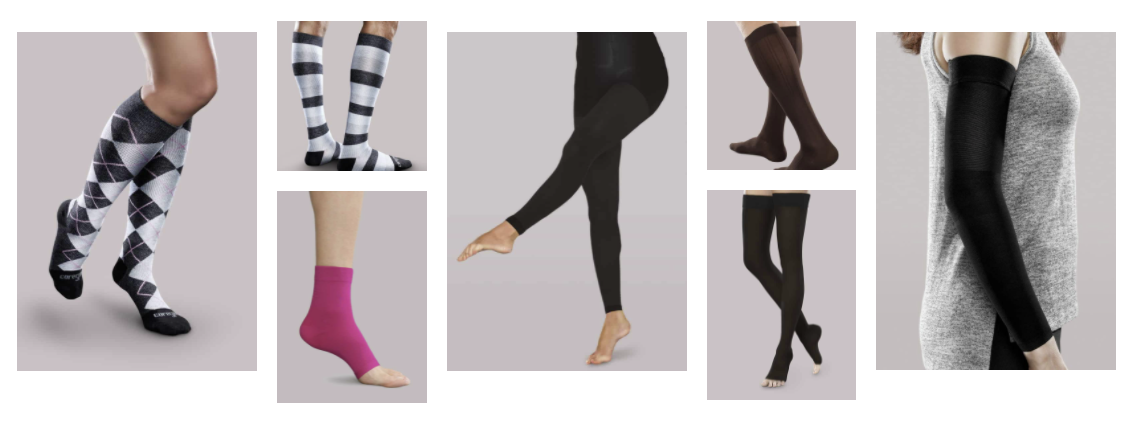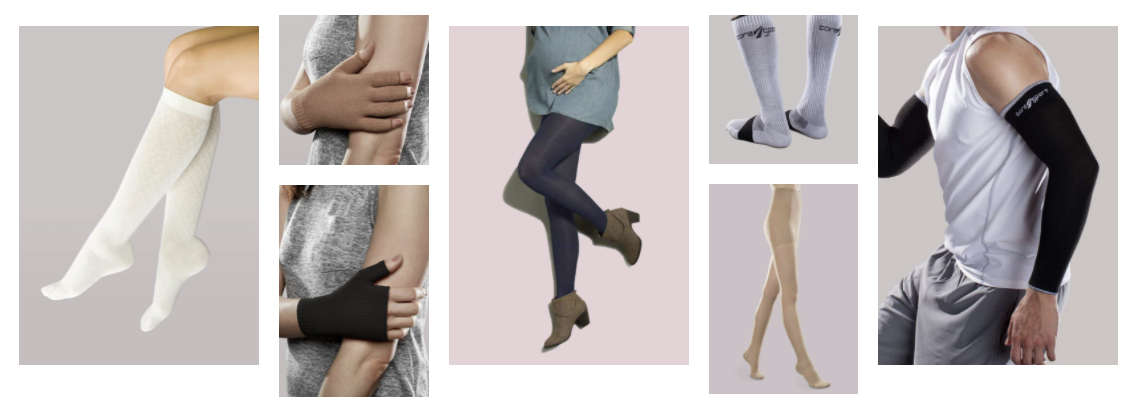Compression Socks, Stockings, and Sleeves
Compression stockings improve blood flow and are designed to deliver a controlled amount of pressure, starting at the ankle, and gradually decreasing towards the top of the stocking. This promotes better circulation to help control swelling and relieve tired and achy legs. The level of compression is measured in millimeters of mercury (mmHG). It’s the same scale used to take your blood pressure.
There are many indications for needing compression garments; facilitating wound healing, preventing swelling when traveling, athletic recovery, and most commonly lymphedema. Most people do not know what lymphedema is until they are diagnosed with it. Once diagnosed, they are shocked and concerned about what to do. There are several different options for treating lymphedema, including various kinds of compression garments.
Compression Levels
The benefits of compression technology are vast. Depending on your condition and use case, compression can be covered by insurance. For compression to be covered by insurance, you must have a prescription. Bedard has fitters on staff that will measure you to make sure you get the right-sized compression. Below is a simple chart that shows which level of compression helps for what conditions but it is up to you and your doctors to ultimately establish what level is right for you.
- 15-20 mmHg: Great for support on busy, active days, or when traveling. Offering day-to-day relief from achy, heavy, slightly swollen legs. No prescription is required to purchase.
- 20-30 mmHg: Used to help chronically painful, heavily fatigued legs. Also ideal for varicose veins, spider veins, swelling (edema) and after surgery. You don’t have to have a condition to wear 20-30 mmHg though. No prescription is required to purchase.
- 30-40 mmHg: This stronger level of compression is recommended for blood clots (DVT), lymphedema, severe swelling (edema), severe varicose veins and post-surgery. Also used to help heal active venous statis ulcers, treat phlebitis, and for bone fractures or after orthopedic surgeries. We require a prescription to be able to purchase 30-40 mmHg and stronger.
- 40-50 mmHg: For severe edema, varicoities, post-thrombotic syndrome (PTS), pronounced CVI (grades II & III), primary and reversible lymphedema, recurrent venous ulceration. This compression level requires a prescription.
- 50-60 mmHg: Recommended for only the most severe cases of post-thrombotic syndrome (PTS), and primary lymphedema. This level of compression requires a prescription.
Caring for Your Compression Garments
Your compression garment is manufactured from the highest quality materials and can be washed in warm water with a mild detergent. Do not use fabric softener or bleach. After washing, lay your garment on a thick towel, roll it up and squeeze any excess water. Then, lay your garment out to dry. Do not dry in a dryer or in direct sunlight. Note: Some materials are dryer-safe; please check with your fitter.
It is recommended that the garment be washed out daily. Do not exceed 2-3 days without proper cleaning. Do not cut any loose threads or snares, as this may result in holes or runs in the garment. This may ruin your garment.
Depending on how much you use the garment and how well you care for your garment will depend on how often you will have to replace them. At the maximum, your garment should be replaced every six months. If you have an increase or decrease of five or more pounds, this can alter the fit of your garment.
Contact your Bedard fitter if you need to reorder your garment. For styles and colors not typically stocked or special orders, it may take 2-3 weeks to receive your item.
How to Put on Compression Stockings
- Use Rubber Gloves: Using common household rubber gloves simplifies the procedure of applying your garment. Rubber gloves allow you to smooth out the fabric with a minimum effort and grip the material. Rubber gloves also protect the fabric from runs/snags caused by fingernails. If you wish to purchase rubber gloves designed for this purpose, ask your fitter at Bedard.
- Use Slip-on Aids: Sometimes, compression garments can be difficult to put on. Ask your fitter about the donning devices we have available.
- Proper Fit and Garment Distribution: It is important to notice that the fabric is woven in straight lines, after application of the garment, make sure seams and stitches run vertically. If this is not the case, use your rubber gloves to straighten the fabric. It is a common mistake to over-stretch the garment while applying it. This leads to a loss of support (compression) in your garment. If the garment is constantly bunching up behind the knee, it is most likely over-stretched. To correct this, simply work the fabric downward towards the calf.
- Use Adhesive Lotion: Sometimes garments slide down the arm or leg. Sliding or rolling of the fabric can reduce the effectiveness of the compression garment and be bothersome to you. This problem can be eliminated with the use of adhesive lotion. If this is a problem with you, talk to your fitter. To use adhesive lotion, put the garment on and turn the top of the border over and apply the adhesive lotion to the area where the garment ends. Allow 3-4 minutes for the lotion to become tacky. Then turn the garment border back over.
How to Measure
Prescription Compression
Many patients will be prescribed garments that will provide compression for an affected limb. The garments help to keep fluid from accumulating in the limb. These garments have specific amounts of pressure and can be worn on the legs, hands, feet, or arms. The garments are made of a tight stretchy fabric. An expert fitter must fit lymphedema garments (sleeves). Measurements are taken, and a patient must try on the sleeves to make certain that they have a comfortable fit.
Sometimes custom sleeves must be made, but most people are able to find a pre-made sleeve in a suitable size. The sleeves prevent the accumulation of more fluid in a limb; they do not pump fluid out of the limb. The garments are usually used in combination with therapy or as a preventative or maintenance measure. Lymphedema sleeves and treatment can change the size of the affected limb, as can various activities.
Sometimes the patient needs more than one sleeve during this process because of the changing size of the limb. There has been a tendency for patients to think that their sleeve has been fit improperly. Sometimes it has been, but more often than not, the limb has changed in size.
Please note: These sleeves wear out with continued daily use, and must be refit and replaced on a regular basis (approx. every 3-6 months). Over time with washing and wearing, they lose their compression. Different levels of compression are used for prevention versus maintenance.
Anti-Embolism Stockings (TED Hose)
Anti-embolism stockings are often confused with regular compression stockings. Though they look similar, there are many differences in their use and design. Anti-embolism stockings apply light and graduated compression along the leg and are solely for the purpose of preventing blood clots in non-ambulatory or post-operative patients. Primarily available as white knee-high or thigh-high styles. These stockings are designed with a small opening that exposes the toes so a patient's blood circulation can be easily monitored. Anti-embolism stockings are not meant to be worn walking around as they may slide down the legs or bunch up at the feet as you walk. Generally, anti-embolism stockings are to be used for short-term compression needs. Patients may wear them for a maximum of three weeks, or until another form of preventing blood clots may be utilized.


